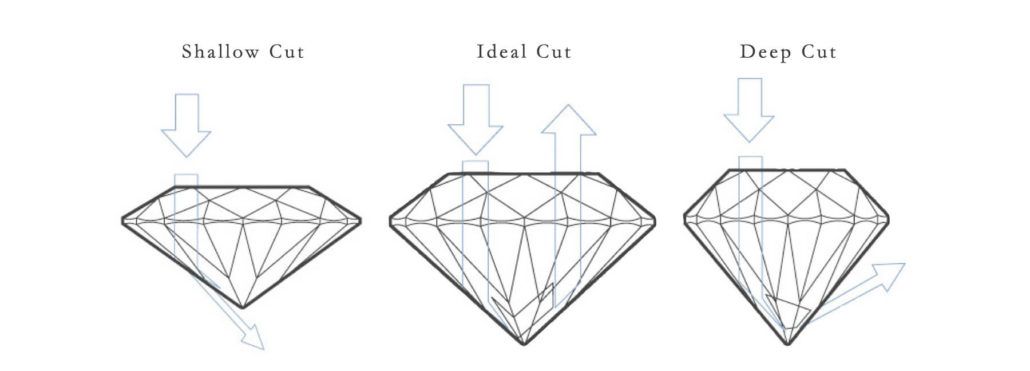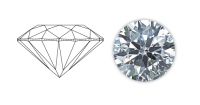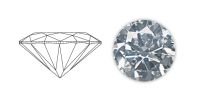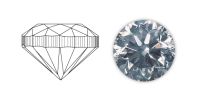The term “diamond cut” refers to the way the diamond is proportioned, with consideration given to depth, width, symmetry, and facet uniformity, as these factors greatly impact the diamond’s brilliance and ability to reflect light effectively.
Ideally, a well-cut diamond ensures that light enters through the crown, bounces off the pavilion, and reflects out of the crown, showcasing stunning brilliance and a fiery appearance.
On the other hand, shallow cut diamonds allow light to escape from the bottom, resulting in a lack of light play and making them appear dull and glassy.
A deep diamond cut diminishes the brilliance and sparkle of the diamond.

| GIA Cut Scale | |
|---|---|
Excellent | 
|
Very good | 
|
Good | 
|
Fair | 
|
Poor | 
|
When it comes to judging the cut of a diamond, experts use a rating system that ranges from Excellent to Poor.
To assess the cut grade, the Gemological Institute of America (GIA) factors in various aspects such as brightness, fire, and scintillation.
Diamonds with an Excellent cut rating typically display superior brilliance and excellent light performance, while diamonds with a Poor rating may lack luster and appear unimpressive.
The cut of a diamond is a critical factor in determining its overall beauty and value.
There are two basic diamond cuts: brilliant cut and step cut.
Brilliant cut diamonds have triangular or kite-shaped facets. They beam with exceptional brilliance and sparkles. The most popular brilliant cut diamond shapes are round cut, princess cut, cushion cut, radiant cut, pear cut, oval cut, marquise cut, heart brilliant cut, and trilliant cut.
Step cut diamonds are square or rectangular, with square or rectangular shaped facets that are parallel lines resembling steps. They radiate long, dramatic flashes of light. The most popular step cut diamond shapes are emerald cut, asscher cut and baquette cut.
The cut quality of a diamond refers not only to the proportions and angles of the cut, but also how well suited it is for the shape of the stone.
These grades have tight proportion tolerances to maximize light performance.
For fancy shapes like princess, oval, or pear, the cutting style has more flexibility to retain carat weight while still qualifying as an “excellent” cut.
Since fancy shapes show off their outlines more compared to rounds, the emphasis is often more on preserving as much width and depth rather than strictly conforming to ideal angles at the expense of brilliance.
Regardless of shape though, each cut grade represents a range from superb light return in the top categories, to lower light performance for stones with too shallow or deep proportions in the “fair” or “poor” classifications.
So while an exceptional round brilliant may not look like an exceptional emerald cut, high standards are aimed for in both when planning the cut.
Cut vs. Shape:
The terms cut and shape are often used interchangeably, but they have different meanings. Cut refers to the arrangement of facets that create an attractive face-up appearance, while shape refers to the outline of the diamond.
Most diamond jewelry features a round shape, while other outlines are known as fancy shapes. Traditional fancy shapes include the marquise, pear, and oval. Hearts, triangles, and other shapes are also becoming popular in diamond jewelry.
Here is a table of the most popular diamond shapes with an explanation, characteristics, and number of facets for each:
| Shape | Explanation | Characteristics | # of Facets |
|---|---|---|---|
| Round | The classic and most popular diamond shape, accounting for 75% of diamonds sold. It is symmetrical from every angle with a circular outline. | Reflects the most brilliance and fire. No vulnerable corners or edges. Balanced appearance from any angle. | 56 or 58 |
| Princess | A square diamond shape with sharp, angular corners trimmed at 90 degree angles. Second most popular shape at 7%. | Give off flash brilliance. Can make the diamond appear larger than round. Shows inclusions more than round. | 50-80 |
| Oval | An elongated shape with curved sides like a stretched round shape, comprising 5% market share. | Offers a brilliance and sparkle between marquise and round. Evenly distributes color for more consistent appearance. | 56-58 |
| Cushion | A pillow-like shape combining rounded sides with angular corners. Accounts for 5% of diamonds sold. | Vintage charm. Hides inclusions well. Softer sparkle than modern cuts. | 58-64 |
| Emerald | A rectangular shape with cut corners, making up 3% of natural diamond sales. | Highlights clarity with large facets. Art Deco style. Can show bow-tie effect in middle. | 50-58 |
| Radiant | A hybrid cut combining rounded sides of an emerald with triangular facets of a round. | Increased brilliance like round. Outline of an emerald or princess. Risk of bow-tie effect. | 62-72 |
